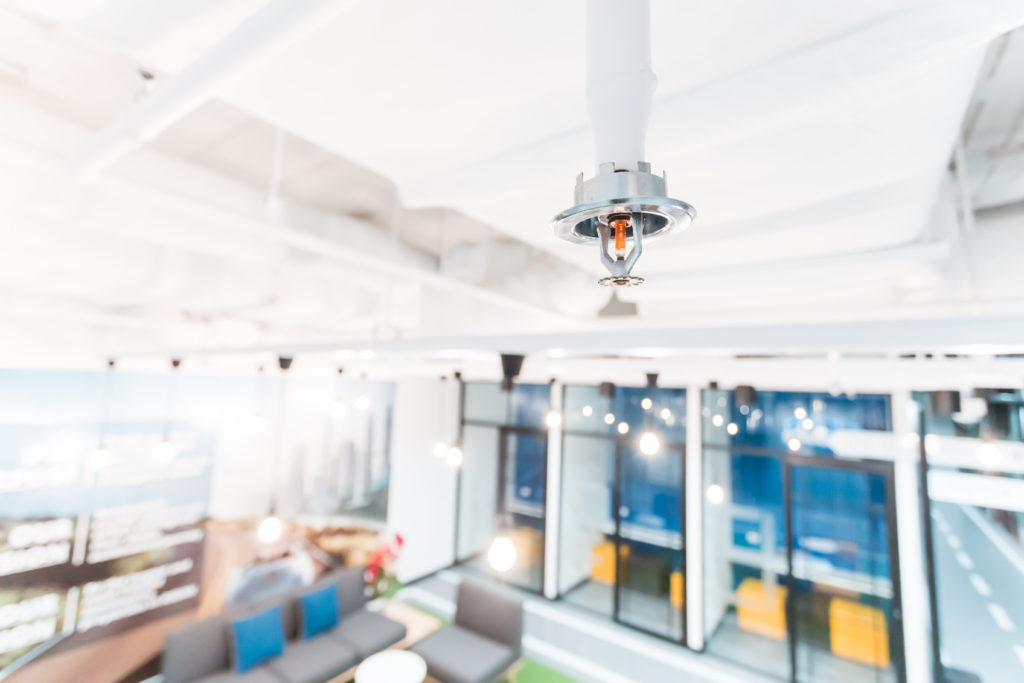Fire alarms, emergency exits, and accessible fire extinguishers are all a part of critical fire safety measures in commercial buildings. But what about sprinklers? No, we don’t mean the sprinklers you ran through in your backyard as a kid. (Although those would be a fun addition.) We mean fire sprinklers that are in place to help distinguish fires in commercial buildings. “When are fire sprinklers required in commercial buildings?” can typically be answered by the size and occupancy of your building. Let’s take a look at:
Inside the Blog

Who Decides Fire Sprinkler Requirements? 👨💼
Fire safety codes in commercial buildings are a big deal. It’s not some random Joe Schmo who makes the rules, but federal organizations and local municipalities. Violating fire codes in your commercial building can result in hefty fines. 💸
The main organizations that set the standards for fire safety are the National Fire Protection Association (NFPA) and the Occupational Safety and Health Administration (OSHA), which is a part of the United States Department of Labor.
- Fun Fire Fact: The first fire sprinkler regulations now known as NFPA 13 date back to the late 1800s when workers gathered to discuss and try to limit fires in New York City.
Additionally, the U.S. Congress passed the Hotel and Motel Fire Safety Act of 1990 which mandated all hotels and motels that accept government funds to meet fire safety codes.
Beyond these governing bodies, the majority of specific fire safety rules about sprinklers are decided by local jurisdictions. While there are general fire safety codes that the entire country needs to adhere to, local codes will differ from each other.
Fire Sprinklers Requirements by Building Size 🏛📏
The NFPA 13 sets the standard for the installation of sprinkler systems in commercial buildings. The following building sizes are required to install a fire sprinkler system:
- All newly constructed commercial buildings with a fire area* of 5,000 square feet or larger
- Any remodels that add square feet to an existing commercial building so that the total is 12,000 square feet or more
- Townhomes with more than two units per building
- Buildings more than 55 feet tall
- Self-storage buildings (except one-story facilities with no indoor corridors and a one-hour fire barrier)
*Fire Area is defined as “the aggregate floor area enclosed and bounded by fire walls, fire barriers, exterior walls, or horizontal assemblies of a building.”
Note that these important fire sprinkler requirements rarely apply to single-family detached homes. At one point in 2006, the NFPA required that all newly constructed one and two-family homes must have fire sprinkler systems, but that mandate has since been reversed in most states. Local jurisdictions are actually now prohibited from enacting ordinances that require single-family detached homes to install sprinklers.

4 Types of Fire Sprinklers Systems 🚿
Sprinkler systems are in place to offer fire protection to the occupants of a building, whether it be an office park, apartment complex, or shopping mall. Sprinklers activate when they detect the fire’s heat, and they spray water to help extinguish or slow the fire. Even if a fire is well underway before the sprinklers activate, they could provide enough suppression to allow people to safely exit the building.
There are many types of fire sprinklers systems, but some of the most common are:
1) Wet Pipe System
Wet pipe systems are the most common type of fire sprinkler system. The simple design is reliable in the face of fires. These systems consist of automatic sprinklers and often an automatic alarm check valve.
This system gets its name because all of the piping is filled with water that is immediately ejected from the sprinklers when they sense sufficient heat from a fire.
2) Dry Pipe System
A dry pipe sprinkler system has pipes filled with air at a lower pressure than the water supply and a large valve that prevents the water from entering the piping when the system is idle. The valve opens when the sprinklers sense extreme heat from a fire, then the air in the pipes escapes and the water can enter the pipes and spray from the sprinklers.
This sprinkler should only be used in regions where the temperature would get cold enough to freeze water in a wet pipe system because this pipe system isn’t as effective during the beginning stages of a fire since the water production is delayed.
3) Deluge System

In contrast to wet and dry sprinkler systems, deluge systems are not activated by heat sensors but by a fire alarm system. Deluge sprinkler systems do not have water in the pipes, but they have a valve keeping the water out.
When a fire alarm is set off, the valve opens, which allows water to flow through the pipes and exit the sprinklers.
4) Pre-action System
Pre-action sprinkler systems combine the mechanics of some of the above systems. They have the flexibility of a wet system with the added layer of protection of a dry and deluge system.
Pre-action systems are filled with air, like a dry system. However, these systems aren’t set off by heat detection or fire alarms but by smoke detectors. This system is most commonly used in museums and libraries where it’s essential to have protection against false alarms that could set off sprinklers unnecessarily.
We Ensure Your Building Is Built to Code 🏢 ✅
At APX Construction Group, we’re experts on commercial construction— it’s all we do! If you’re unclear about fire codes or fire sprinklers for your new commercial establishment, you can trust that our team knows what needs to be incorporated so that you’re up to code.
Reach out to our friendly team with any questions, and we’ll be happy to answer them!

